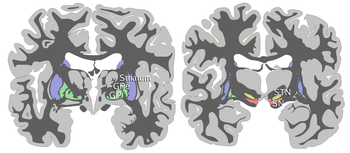纹状体
紋狀體(英文:Striatum)是端腦皮質下的一部份,位于上丘脑。這是基底核的主要輸入區。在解剖學上,紋狀體包括了尾核(Caudate nucleus)和被殼(Putamen)。 具有调节肌肉张力、协调复杂运动的功能。纹状体依赖多巴胺才能正常工作,因此分泌多巴胺的细胞死亡(即黑质细胞),就会患帕金森疾病。

歷史
编辑在17世紀與18世紀時,詞彙「Corpus striatum」(紋狀體)用于称呼腦半球深色的皮質下部分(Vieussens, 1685)。福格茨(Vogts)(Cécile and Oskar, 1941)簡化了命名法,提議將「striatum」詞彙用在所有紋狀的組成元素(參見主要基底核系統),包括尾核(Caudate nucleus)、被殼(Putamen)與基層紋體(fundus striati),後者是前述二部份連結至內囊(internal capsule)以下的腹側部分。
「neostriatum」(新紋狀體)是由比較解剖學家所創造的辭彙,他們比較了脊椎動物間的下皮質結構,因為新紋狀體被認為是腦部紋狀體的系統發生的新生部分。
參考文獻
编辑- Aosaki T, Kiuchi K & Kawaguchi Y (1998) Dopamine D1-like receptor activation excites rat striatal large aspiny neurons in vitro. J Neurosci 15, 5180–90
- Apicella P (2002) Tonically active neurons in the primate striatum and their role in the processing of information about motivationally relevant events. Eur J Neurosci 16, 2017–26
- Cossette, M., Lecomte, F. and Partent, A. (2005) Morphology and distribution of dopaminergic intrinsic to human striatum. J. Chem. Neuroanat. 29: 1-11
- Holt DJ, Graybiel AM & Saper CB (1997) Neurochemical architecture of the human striatum. J Comp Neurol 21, 1–25
- Morris G, Arkadir D, Nevet A, Vaadia E & Bergman H (2004) Coincident but distinct messages of midbrain dopamine and striatal tonically active neurons. Neuron 8, 133–43
- Tepper JM & Bolam JP (2004) Functional diversity and specificity of neostriatal interneurons. Curr Opin Neurobiol 14, 685–92
- Yamada H, Matsumoto N & Kimura M (2004) Tonically active neurons in the primate caudate nucleus and putamen differentially encode instructed motivational outcomes of action. J Neurosci 7, 3500–10
- Yelnik, J., François, C., Percheron, G., Tandé, D. (1991) Morphological taxonomy of the neurons of the primate striatum. J. Comp. Neurol. 313:273-294
- Zink, CF, Pagnoni G, Martin-Skurski ME, Chappelow JC, & Berns GS (2004). Human striatal responses to monetary reward depend on saliency. Neuron 42, 509-17
參照
编辑- 人腦區域列表(List of regions in the human brain)